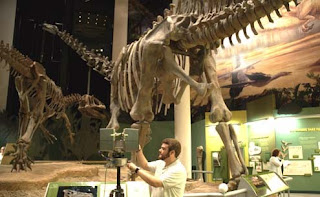Prehistoric reverse engineering brings dinosaur bones to life
 From the Institute of Industrial Engineers Web site - the Global Association of Productivity and Efficiency Professionals
From the Institute of Industrial Engineers Web site - the Global Association of Productivity and Efficiency ProfessionalsWhen paleontologists from the Sam Noble Oklahoma Museum of Natural History decided to display the bones of a juvenile apatosaurus, they ran into a problem. They only had 15 percent of the bones required to form a display skeleton of the dinosaur. It is not unusual to find so few bones, but it does pose a challenge. In order to create molds of the complete dinosaur, each individual bone needed to be sculpted from clay by referencing similar bones, images of bones, and domain knowledge. This can be a very time consuming project that requires many volunteers and scientists.
Fortunately the University of Oklahoma paleontologists met with the engineers at the Center for Shape Engineering and Advanced Manufacturing (SEAM) at the university. SEAM was founded by OU School of Industrial Engineering faculty members Shivakumar Raman, an IIE fellow, and Binil Starly to provide research and development solutions to the aerospace maintenance, repair, and overhaul and biomedical industries, among others. By utilizing the tools and skills of SEAM, more efficient and precise methods of modeling the juvenile apatosaurus were developed.
Three different methods for creating virtual three-dimensional models of the bones were employed. When the virtual solid models were created, they were then printed in plastic, using a rapid prototyper, or a 3-D printer. Once printed, the paleontologists will take the plastic bones and will create the molds that will go on display in the museum.
The first step in creating a virtual dinosaur was to make the computer models of the existing juvenile bones. SEAM used a FARO Arm: Platinum Laser Scanner to collect millions of points in the shape of the bones. These points were connected through triangulation into a solid model and edited using GeoMagic Studio software. From there the model was imported into ProEngineer where it was further edited and sent to the 3-D printer. With this new method, if only the right tibia was found, the left tibia can easily be created by simply mirroring the model of the right. This greatly deceases the time spent reconstructing the dinosaur.
The second technique used to reverse engineer the juvenile apatosaurus was creating a model of the adult apatosaurus on display at the museum. SEAM engineers did this using the FARO Photon Laser Scanner. Unlike the FARO arm, the photon scanner collects the points of large-scale objects.
In less than a week, the engineers had scanned the entire dinosaur, which is about 25 feet tall and 45 feet long. Hundreds of the missing bones were captured in a single set of scans. Because the photon scanner is so unobtrusive, the museum exhibit remained open during the scanning. In GeoMagic, individual bones were isolated, transformed into solid models and scaled to the correct anatomical dimensions. Instead of sculpting bones from scratch, many of the missing juvenile bones were derived easily from the adult bones.
SEAM used a third method for the bones of the juvenile apatosaurus that were slightly different from the adult bones. Once models from these bones were created, they were brought into software called FreeForm Modeling. In FreeForm Modeling, the virtual model takes on the characteristics of being made out of clay. The model is then sculpted into the correct shape using a Phantom Desktop haptics tool. This pen-like tool applies pressure to your hand as you “sculpt” the clay computer model. Although this method requires the same skill and time to sculpt as a physical model, it easily can be edited, scaled or multiplied in the computer. Another application for the haptics tool helped with the bones that could not be easily accessed and scanned on the adult dinosaur. These bones could be sculpted from a lump of virtual clay.
Each method allows for all the 292 juvenile apatosaurus bones to be reconstructed more efficiently, in less time and with fewer volunteers. The Sam Noble Oklahoma Museum of Natural History and SEAM collaboration allowed for a unique application of the reverse engineering tool and processes.
“While SEAM is ultimately interested in collaborative relationships with government and industry organizations, this project has provided our faculty and students with a new perspective on the capabilities of our equipment in a field where this technology is not common,” Starly said.
About SEAM
SEAM emphasizes research and development efforts toward the sustainment of large-scale systems with particular interest in the needs of the aerospace MRO industry, as it is geographically located where much of the nation’s aerospace MRO operations reside. SEAM works with commercial, government and academic organizations to provide robust shape engineering and advanced manufacturing services, including end-to-end reverse engineering and re-engineering capabilities, metrology and geometric conformance, computer-aided design, rapid prototyping and manufacturing, reconfigurable manufacturing, nondestructive inspection and material characterization capabilities and prognostics research.


